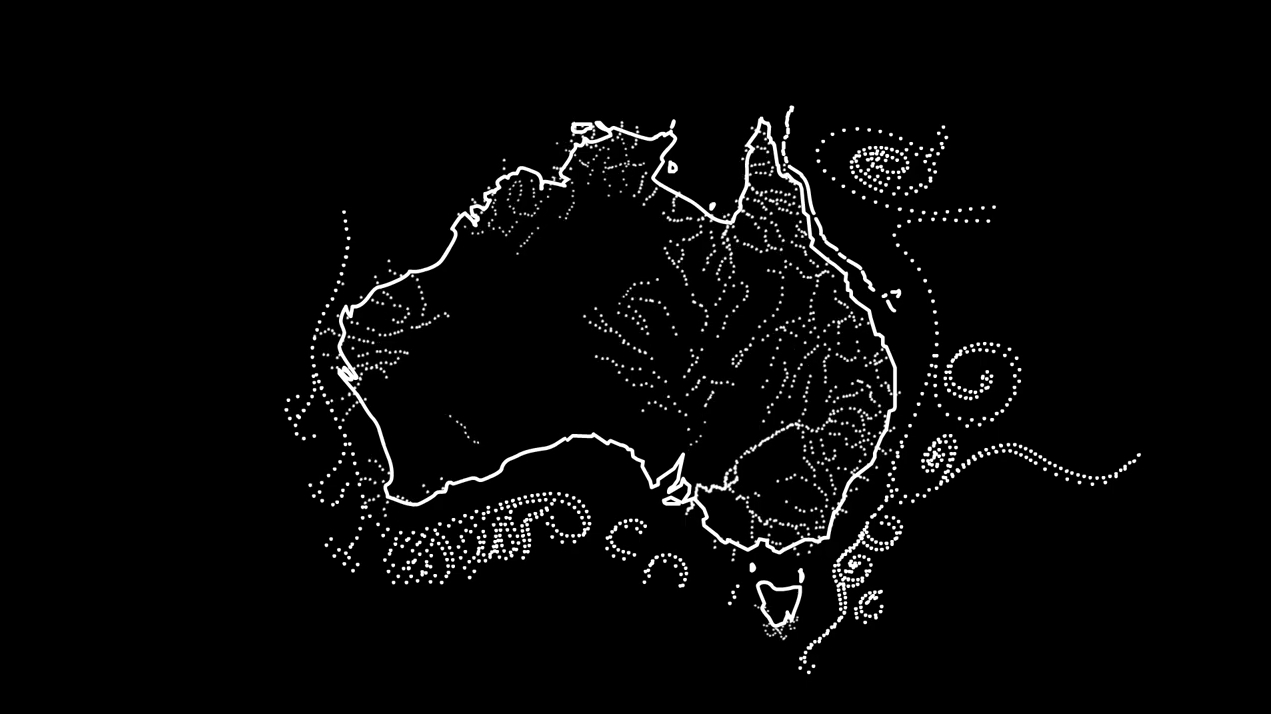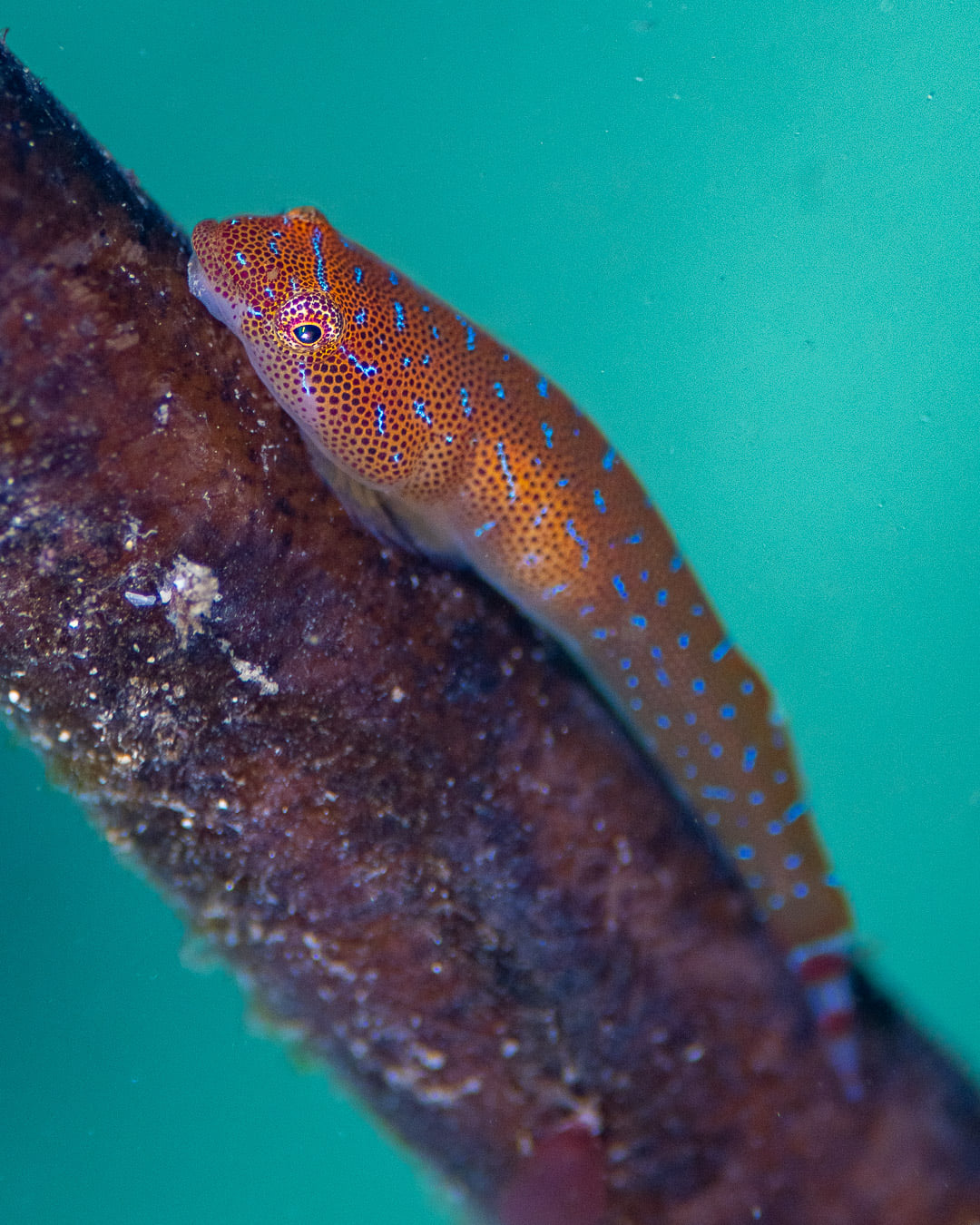Map
| ID | Location | Taxonomy Terms | ||||
|---|---|---|---|---|---|---|
| 2784 | We loved each other | Bass Strait, Carmel Bird, Lisa Roberts | Carmel Bird wrote (in 2022): ‘The British claimed as their own the land that had for many thousands of years belonged to the Aboriginal people. A state of war, known as the Black Wars, existed between the invaders and the original landowners. The savage British imperialists liked to imagine they had eradicated the Aboriginal people, but in fact the people had survived, knowing themselves to be the true owners of the land.’ Lisa Roberts: When I heard Carmel’s story of the mother’s fear of death changing the love the mother had for the child, I thought about separations within my own family. Could it be that some of these were related to another fear? Did the dread of exposure of our roots in the ancient peoples of this land split my family in ways that appeared to me at the time to be incomprehensible? Her story also triggers memories of other people I have witnessed demonising Mother nature as a way of coping with their fear of her. Demonising the very victim of their abuse. I find great strength and courage in recognising the feelings in Carmel's story spiralling out from the personal to the universal. 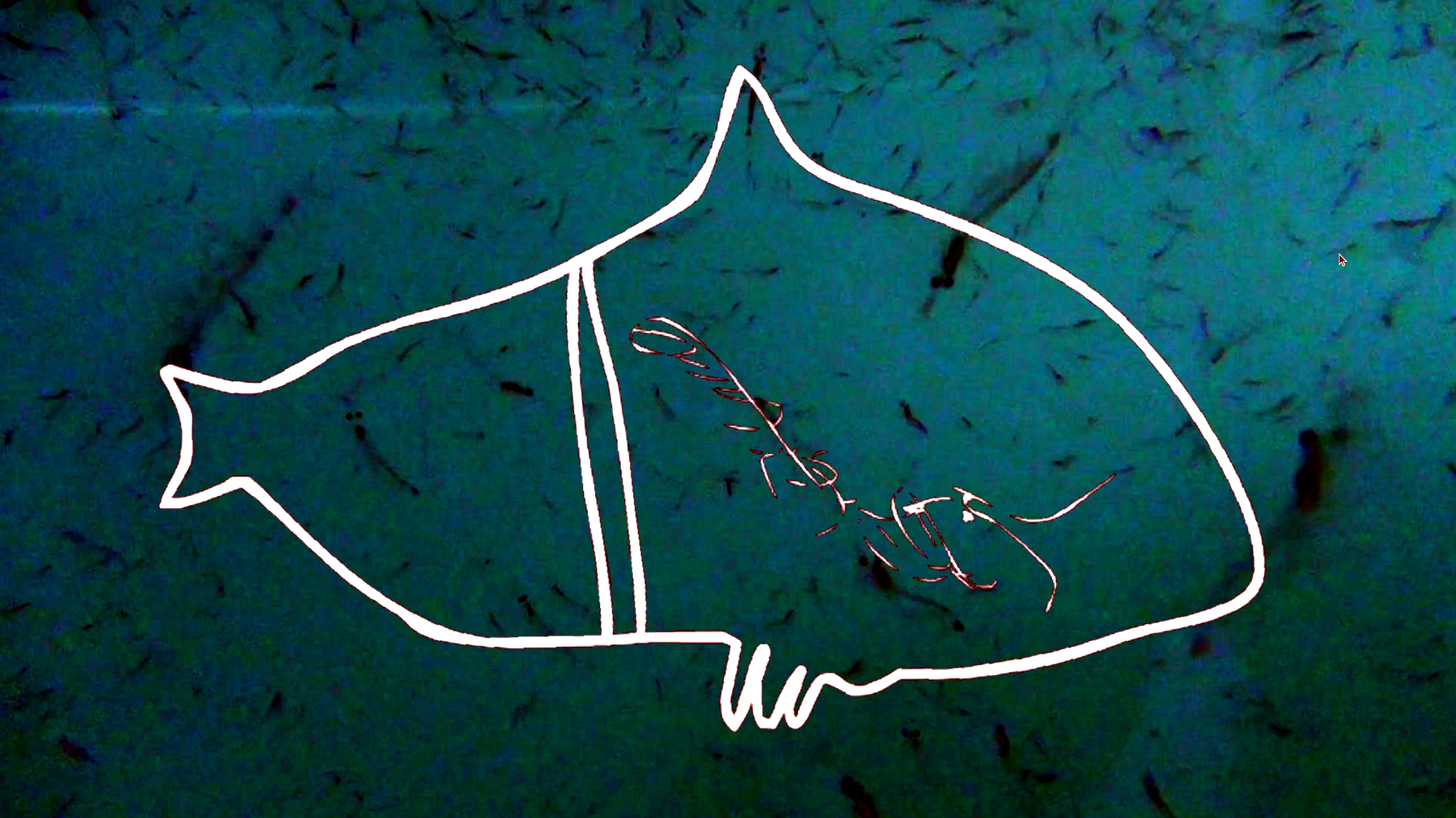
Whale and Krill, ancient ancestors of Humans |
-41.26, 147.08 | Art | http://www.lunartime.net.au/content/library/sandtalkminds/story/Singer-story.php |
| 2783 | Salt and fresh waters dance | Australian rivers and ocean currents, Lisa Roberts | When dancer and musician Eric Avery asked artist Lisa Roberts if they could dance together she made this animation.
|
-33.89, 151.179 | Indigenous Cultural Knowledge, Art and Scientific Method | https://www.youtube.com/watch?v=Mbf0mPqO4g0 |
| 170 | Spirit seeding | Lisa Roberts, Maddison Gibbs | Barkindje artist Maddison Gibbs creates this necklace of eucalyptus flower seeds from Wiradjuri Country, Kandos, New South Wales, and on Monday 1 November 2021, as the moon is waning over Bpangarang Country, Beechworth, Victoria, it arrives to share 'love, strength, thoughts and spirit'. |
-36.335, 146.68 | Indigenous Cultural Knowledge and Art | http://www.lunartime.net.au/content/library/sandtalkminds/kinship/spirit-kinship.php |
| 169 | Rebuilding at Wheoh | Simon Pockley | 
Watch video: https://www.youtube.com/watch?v=g586hgqwV-4 On Sunday, 12th January 2013, a bushfire (named Wambelong) escaped from the Warrumbungle National Park. It swept through Wheoh, burning plants, wildlife and the 36 year old hand-made house built on a small sandstone rise among scribbly gums (E. rossii). The impact on our family and Wheoh is most eloquently expressed by my daughter, Bonnie, in two of her own blog posts: In Memoriam (15th January 2013) and The Lonely Bones (19th January 2013). Our family, as well as visitors, were accustomed to recording thoughts in hand-written journals (dating back to 1975). Sadly, the volume covering the years 2011-2013 was lost in the fire as well as a memory painting (above). Earlier volumes, removed in anticipation of the fire, have now been returned. In July 2013, I began the process of rebuilding and more volumes are being shelved. This, more fire proof and publicly accessible record, consists of 3 minute videos with occasional written posts. It's an attempt to capture the resilience of a fire ecology for family, friends, and anyone attracted to the serenity of reclusion, self-sufficiency and the process of making things out of what comes to hand. If I have a guiding principle it's a sense of gratitude that nothing lasts, is finished, or is perfect. Thoughts on my own sense of belonging In Place. In 2019, drought records were broken with a mere 167.6 mm annual rainfall (average 600 mm). See 100 years of data 1886-2020.
|
-31.45, 149.16 | Art and Scientific Method | http://www.duckdigital.net/Wheoh/ |
| 167 | The Dying Darling | Sarah Moles | Writer Sarah Moles and artist Michael Pospischil notice the river is in bad shape. Over the course of a year or so they travel the length of it talking to scientists, irrigators, Indigenous owners and the politicians about their view of the Darling. |
-28, 152 | Art and Scientific Method | http://www.lunartime.net.au/content/places/murray-darling-basin/darling-downs/darling-downs.php |
| 166 | A Botanical Garden tells stories | Darren Charlwood | 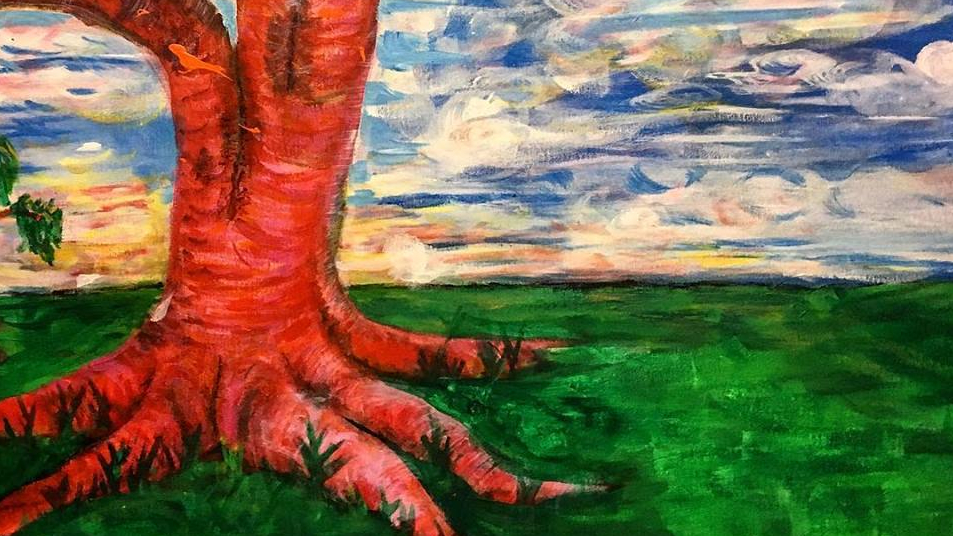
|
-33.8642, 151.2166 | Indigenous Cultural Knowledge, Art and Scientific Method | http://www.lunartime.net.au/content/places/sydney-basin/sydney-botanical-gardens.php |
| 165 | Parallel | William Gladstone |
Two Flutemouth, swimming in opposite directions, pass one another under the jetty at Chowder Bay, Sydney Harbour. |
-33.48, 151.5 | Art and Scientific Method | |
| 164 | Clingfish | William Gladstone | August 5, 2021. Waiting for the next client. An Eastern Cleaner Clingfish rests on the trunk of Golden Kelp plant, waiting to clean the next fish that arrives at its cleaning station. Local Clingfish know the locations of cleaning stations and return again and again for a cleaning. This Clingfish is about 30 mm (a little more than 1 inch) long.
|
-33.49, 151.5 | Art and Scientific Method | |
| 163 | Shell necklaces | Katherina Petrou, Lisa Roberts |
This report, accessed today, 27 Sept 2020, tells of fears that disruptions to natural climate patterns will disrupt traditional cultural practices in Tasmania: https://dailygreenworld.com/2020/08/09/earth-changes/earth-changes-earth-changes/arctic-antarctic/fears-indigenous-tasmanian-necklaces-could-become-lost-art/ Palawa artist Lola Greeno 's practice of making shell necklaces dates back hundreds (perhaps hundreds of thousands) of years. Around 2004 I met Lola at the National Folk Festival in Canberra where she was selling some of her pieces. The photo above shows a necklace and bracelet I bought from her then. The white shells are 'cockles'. The black ones are 'black crows'. It's the maireener shells Lola also uses that are threatened. She reports, “My prediction is — and I hope I’m wrong — in 10 years, you will hardly see any maireener shells to make necklaces out of, sadly...” |
-40.782, 148.026 | Indigenous Cultural Knowledge, Art and Scientific Method | |
| 158 | Isle of Lewis | Malina Monks | Artist Malina Monks speaks from her home in the Channon, Australia, about her Scottish Gaelic cultural heritage. Born and raised on the Isle of Lewis, the most north-west island of Scotland, her animated language reflects the rhythms in nature she grew up with. Malina perpetuates her knowledge of rhythms in nature through weaving, ceramics, and story telling. She reflects on the cultural dis-posession of her ancestors during the "Highland and Ireland Clearances" and gives vivid descriptions of their world that she was fortunate to inherit and pass on to her family.
|
58.21901, -6.38803 | Indigenous Cultural Knowledge and Art | https://youtu.be/UVG-bJgSfxc |
| 157 | Tree spirit | Gwanji Monks with Lisa Roberts |
Gwanji Monks, September 2020: "...I very much respond to the material itself. So as soon as this piece [Australian red cedar root] presented itself to me, I was confronted by this angel form. My brother [Chico] just recently passed, and so this is a response to that..."
|
-28.39, 153.16 | Indigenous Cultural Knowledge and Art | http://www.lunartime.net.au/content/library/sandtalkminds/kinship/tree-kinship.php |
| 156 | Mystery Bay Ocean Dance | Lisa Roberts with Gadu (Ocean), Andrew Constable, Paul Fletcher | "...On the evening of August 21, 2020, I stood on rocks at Mystery Bay, new South Wales. I stood with my partner beneath Guluga, the sacred mountain of the Yuin people. We came with technology to share with Gadu (Ocean) and Guruwal (Whale), some recordings of dance, song, music and poetry, to mark this start of Guruwal's journey South with her children, to feed on Euphausia superba (Antarctic krill). Dance, song, music and poetry is inspired by the complex choreography of the Global Ocean's continuous transformation from clockwise motion around Antarctica, with the Circumpolar Current spiralling upwards and outwards through the tropics, and dancing northward anti-clockwise through the Arctic." 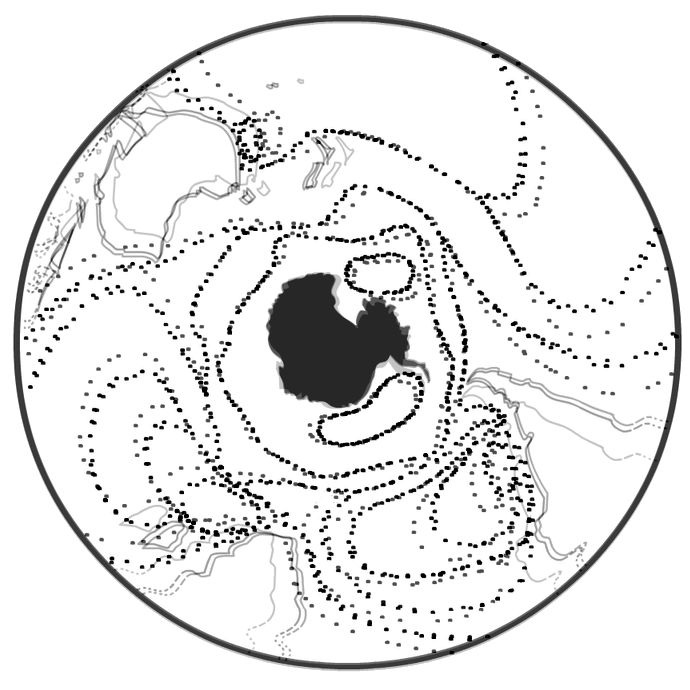
Dotted lines indicate the transformation of clockwise circumpolar currents around Antarctica, to their clockwise motion as they move to the Arctic region.
|
-36.30361, 150.13028 | Art and Scientific Method | https://www.youtube.com/watch?v=_umuckd3leE&feature=share&fbclid=IwAR3L2ArKKhaCRuj8vmqUv88fwBrD40KkUEO8fMIQUGwZ-yjD5udTrfiNDw8 |
| 155 | The Art of Making Images | Danae Fiore, with Review by Melissa Silk |
Melissa Silk Review, 2020 In this scholarly work, Fiore presents the relationship between the Yagan First Nations people of Tierra del Fuego, the land, water and sociocultural systems as not only represented in images applied to tools, ornaments, non-utilitarian objects and bones, but also evident in material procurement and pigment production processes, which they traditionally used to create a wide array of body paintings, many of which embody ancestral beings and spirits with deep connections to the fauna and landscape. Such connections are still very present and active in the Yagan First Nation. We would be wrong to assume there is, or was, little connection between art/making and the Southern Ocean given its proximity to the ancestral territories of Tierra del Fuego’s Indigenous populations. |
-54.86, -67.32 | Indigenous Cultural Knowledge and Art | https://link.springer.com/article/10.1007/s10816-020-09474-7 |
| 150 | Whales return to land | Max Dulumunmun Harrison, Bruce Pascoe, Katherina Petrou, Lisa Roberts | 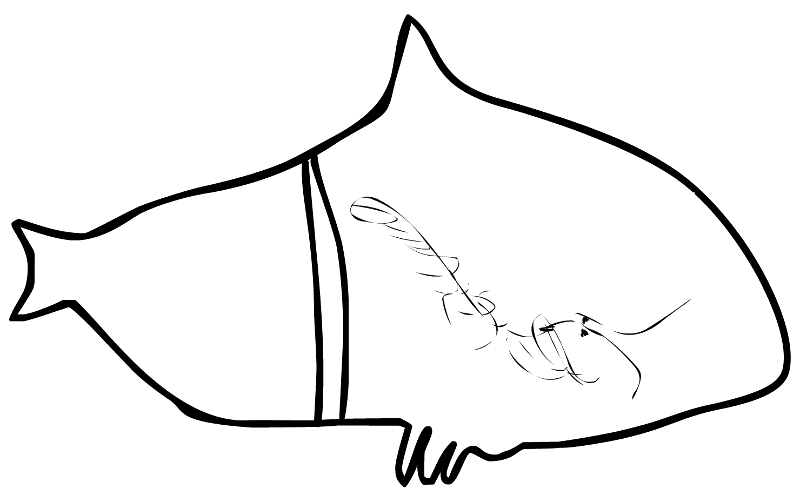
Max Dulumunmun Harrison: Bruce Pascoe: Katherina Petrou: Lisa Roberts:
|
-36.378, 150.13 | Indigenous Cultural Knowledge, Art and Scientific Method | http://www.lunartime.net.au/content/about/aboutwhy.php |
| 149 | Ocean Dance (v6) | Stephen Taberner, Paul Fletcher, Lisa Roberts |
"... Guided by choreographer Barbara Cuckson, I dance the transformation from clockwise circumpolar currents around Antarctica to the anticlockwise currents of the Arctic region. With bands of white paper taped around my head, wrists and ankles, the dance is video recorded under ultraviolet light. Animator Paul Fletcher then layers the light-traced gestures to reflect his experience of 'Flow' in our conversations with scientists and other artists, about the vital role of the Southern Ocean for human and planetary health." "... “FLOW” - a perennial fascination for much timebased art of course Stephen Taberner:
|
-60, -150 | Art and Scientific Method | http://www.lunartime.net.au/content/library/sandtalkminds/ancestor/ocean-dance-ancestor.php |
| 147 | Ocean dance poem | Andrew Constable, Lisa Roberts, Paul Fletcher et al. |
Song, dance, rituals and more, use metaphors to connect ways of thinking that range from abstract to tangible. Flows of cultural knowledge through different times and places, inform and reinforce protocols necessary for maintaining healthy relationships between peoples and countries. Such protocols may be understood as Treaties, or agreements people make to live well together. Animations made from conversations between people can bring together different responses to the same phenomenon. These animations may be thought about as 'collective animations', made by groups of people to reflect their different minds at work, that may provide a more holistic view. Collective animations may evolve, like the conversations that sustain them, but expanding as new data and stories open up new meanings, ideas, and questions for further investigation. Collective animations can evolve as iterations that change to reflect new scientific data and new insights into ancient stories from cultural knowledge. An early example of collective animation is Oceanic Living Data. Three animations have been made from this collective process, with knowledge shared about the Southern Ocean: Ocean dance (v05), Ocean Dance (v6) , Mystery Bay Ocean Dance
|
-68.438, 160.234 | Art and Scientific Method | http://www.lunartime.net.au/content/library/sandtalkminds/pattern/ocean-dance-poem-pattern.php |
| 146 | Sea Change – Tai Timu Tai Pari Hauraki Gulf Marine Spatial Plan | Permission given to Tracey Benson to share from co-author Desna Whaanga-Schollum | Sea Change – Tai Timu Tai Pari (Hauraki Gulf Marine Spatial Plan) He taonga tuku iho – treasures handed down from the ancestors. The Hauraki Gulf / Tīkapa Moana is an incredible natural environment and a nationally significant place. For over a millenia, it has been a taonga to the people who belong to and identify with it. The Gulf is now under significant pressure, and its communities have seen a marked decline in its mauri, environmental quality and abundance of resources. Sea Change – Tai Timu Tai Pari is your Hauraki Gulf Marine Spatial Plan, a collaborative effort between mana whenua, local and central goverment agencies, and local communities and interest groups. It includes a number of significant principles, proposals and innovative measures to manage and protect the Gulf, and help deliver on our shared vision. A vision of the return of Hauraki Gulf / Tīkapa Moana as a place that is vibrant with life, has a strong mauri, is productive and supports healthy and prosperous communities. About the Plan Sea Change – Tai Timu Tai Pari is a ground-breaking initiative, designed to secure a healthy, productive and sustainable future for the Hauraki Gulf . It will deliver a marine spatial plan towards the end of 2016. This plan will ultimately inform how the Hauraki Gulf is shared, used and stewarded for future generations. We need Sea Change – Tai Timu Tai Pari because environmental indicators tell us the Hauraki Gulf is an ecosystem under real pressure. Successive State of our Gulf reports clearly demonstrate the more we all use the gulf, the harder it is to keep it healthy. Until now, managing pressures on the gulf has been difficult, because different agencies are responsible for managing and regulating different activities within the marine space. Through Sea Change – Tai Timu Tai Pari, these agencies are turning to interest groups, communities and other stakeholders to work together collaboratively to find a solution. You can read in more detail about the challenges and opportunities facing the Gulf in our Sea Change – Tai Timu Tai Pari factsheet. Mana whenua, Auckland Council, Waikato Regional Council, territorial authorities, the Department of Conservation, Ministry for Primary Industries and the Hauraki Gulf Forum have all recognised that working in partnership – and empowering a wide range of stakeholders – is a way to get the best outcomes from the management of the gulf and its resources. You can read more about their partnership, and the Stakeholder Working Group (SWG) supporting the process, in who’s on board. |
-36.6, 175 | Indigenous Cultural Knowledge, Art and Scientific Method | https://www.seachange.org.nz/ |
| 145 | Drawing with fire | Terangi Roimata Kutia-Tataurangi and Tracey Benson | At SCANZ Ocean*Energy residency in Mahia, Aotearoa. A collaboration between Māori artist Terangi Roimata Kutia-Tataurangi and Tracey M Benson. We made some runes and released them to the ocean, as Terangi recited a karakia (a prayer). |
-39, 177 | Indigenous Cultural Knowledge and Art | https://traceybenson.com/2017/03/22/rune-journeys/ |
| 144 | The Silence: Puanga | Maata Wharehoka and Tracey Benson | Parihaka Kuia Maata Wharehoka and Tracey Benson collaborated to create a body of work for the Puanga Kai Rau Festival in 2019. The festival celebrates the rise of the star Puanga (Rigel) which marks the beginning of the Māori new year on the west coast of Aotearoa. The working title of their ongoing collaboration is The Silence: Puanga. Maata and Tracey first met in 2015, when SCANZ2015 participants visited Parihaka to learn about cultural contexts for water. Tracey was very drawn to Maata’s work – especially her incredible efforts in reinvigorating Māori cultural practices around death and burial. The process is known as Kahu Whakatere and is based on traditional Māori beliefs, uses a waka or transporter made of natural wood, rather than a coffin. The body is also wrapped in a kopaki (mat) which is made from harakeke (flax). In The Silence: Puanga, the artists explore time, the universe, place and story. The narrative threads which connect to our respective ancestors which we explored:
We used a range of media including weaving, photography/videography, blogging and bookmaking to develop a body of work for the festival in 2019. |
-39.2, 173.8 | Indigenous Cultural Knowledge and Art | https://traceybenson.com/category/art-projects/the-silence-puanga/ |
| 143 | Walking with the Ancients: Waters of the Past | Tracey Benson with DNA music by Josiah Jordan | In 2017, I returned to the village of my great great grandfather in Norway, to visit the church where I had traced my family from the parish book. The church had been standing on the site in Klokkastrua from 1150. The church was closed. I searched the graveyard, looking for a trace of my kin, finding no evidence. I felt dejected, not finding any connection to my ancestors. Then I noticed a big old Oak, standing proudly at the gate of the church. I realised that this Oak had witnessed my family, that it knew my ancestors. It had stood watching quietly the marking of significant events - baptisms, marriages, funerals. Overcome with emotion, I sat down under this ancient Elder, huddling close the the trunk of the tree, resting in the calm truth of time for what seemed an eternity. Opposite the church there was a building, which looked like a small school but it happened that it was studios and a gallery, the Kulturhuset Hovtun. I met the manager, Maria, herself an artist. I mentioned that I was also an artist on a residency undertaking a project on ancestry in Drammen. She showed me around the studios and I told her about a recent video work that had a layered sound piece with music made with my DNA. I described my work as 'a meditative piece', which the curator found interesting, inviting me to present the work as a meditation in an evening of presentations and discussions around art, science and spirituality. To sit in an ancestral place to share a work dedicated to my ancestors felt incredibly profound and 'meant to be.'
|
59.6, 10.5 | Art and Scientific Method | https://vimeo.com/314429100 |
| 141 | Echidna | Leanne Lovegrove |
Leanne Lovegrove is a woman of the Worimi, Biripi Nation, born in Sydney in 1962 and raised in the Thungatti Nation (Kempsey). She is a writer and an artist and works as a librarian at the Eora TAFE Library, Sydney. One of her personal totems is the echidna. Here the echidna tells its story through Leanne's writing and sculptural art. This story of the echidna is part of her contribution to the 2020 Exhibition and Symposium, 'Listening in the Anthropocene', hosted by Charles Sturt University where she trained to be a librarian.
|
-31.07898, 152.83093 | Indigenous Cultural Knowledge | http://www.lunartime.net.au/content/library/sandtalkminds/kinship/echidna-kinship.php |
| 140 | Way of the Turtle: Exchanging Breath | Collaboration with Lee Joachim, Martin Drury, Tracey M Benson. Vocals by Jo Tito and Sharon Atkinson. | The work for Water, Peace, Power at Parihaka seeks to acknowledge both the tangata whenua (people of the land) of Parihaka and the yenbena (Proud, Strong, Aboriginal People) of Yorta Yorta Nation. This site specific work is the first stage of the Way of the Turtle project, which focuses on cultural and community empowerment, skill sharing and finding the interconnections with other cultural perspectives. The project considers many layers of connection between water, land and people. The contiguity of the work includes the Dhungala creation story in Yorta Yorta and English languages, and data obtained via community engagement via TurtleSAT. This work acknowledges one of the Yorta Yorta totems, the Bayadherra (turtle) and the importance of the river to all life. The Yorta Yorta belief is that “we are the land and the land is we”. The river represents our bloodstream, the mist represents our sweat and the rain represents our tears. In saying this, we also acknowledge the agreement made between the Crown and the Whanganui iwi which has given the Whanganui River legal rights as a sentient being. “We are the river and the river is we” |
-39.3, 173.8 | Indigenous Cultural Knowledge, Art and Scientific Method | https://traceybenson.com/2016/03/05/way-of-the-turtle-at-water-peace-power/ |
| 133 | Tidalectics | Eveline Kolijn et al. |
"The Tidalectics Portfolio showcases an interplay between printmaking and marine biology, by presenting the visual response of the artist to the research of the scientist. It follows both the historical tradition of graphically depicting the natural history of the ocean and the contemporary story of pressures on marine environments. Eleven international printmakers have been invited and connected with eleven ocean- and marine biology researchers. They created a visual response on the scientific research. The research unravels the environmental mechanisms at play and consequences for certain organisms such as coral and algae. There is focus on species such as sponges and manatees, on ocean winds and currents. Human ingenuity has harnessed bacterial filtering in traditional salt harvesting. Humans can now also propagate baby corals. We keep discovering hidden patterns in the sea and learn more about the influential role of life forms such as bacteriophages in the state of microbialised seas. In the age of the Anthropocene, the ontology of the ocean as an endless amorphous reservoir has changed towards seeing it as an entity, subjected to the effects of human actions. One of these ontological oceanic imaginaries is tidalectics. To Barbadian poet Kamau Brathwaite the ocean signifies a “tidal dialectic”, rooted in rhythms expressing anti-colonial sentiments. It draws on the rhythmic fluidity and cyclic movements of water. The concept of tidalectics has been adopted by curator Stefanie Hessler as a starting point to formulate an oceanic worldview, that engages differently with the ocean. “The fluidity and ripples allowing us to think of hybridity, cross-cultural syncretism, incompleteness, and fragmentation.” It envisions a dynamic merging and moving between the arts, sciences, history and environmental studies." Eveline Kolijn, Artist-curator, 2020 |
21.368, -78.6569 | Art and Scientific Method | https://www.youtube.com/watch?v=oaGHYoX7udA |
| 132 | Ammonite Aria in Cathedral of Thorns | Eveline Kolijn |
Eveline Kolijn, 2020 |
12.16957, -68.990021 | Art and Scientific Method | https://www.youtube.com/watch?v=zhHhznFIgpk |
| 131 | Masson Range | Fred Elliot, Lisa Roberts, Josef Goding, 2008 |
"Veteran Antarctic expeditioner Fred Elliott sent me an annotated copy of his photolithograph, Masson Range, 1997, and of the photo he took there in 1955. In response to my question, 'what did you change in the landscape you drew?', he wrote, The shape of the snowdrift has been altered to lead the eye into the picture. This [rock form] has been changed into a broad arrow-head plunging into the heart (albeit a white one!) of the composition. There are plenty of ways down from here [top of ridge] but some were a bit 'iffy' so I made one that I could manage! These shapes [overhangs] are emphasised for pictorial values. I invented a lead up from the foreground ice to the centre of the crux of the twisting. That hand contraction I mentionedis DUPUYTREN'S CONTRACTURE. There was a meltwater stream running between the rock and the ice... It was the feeling of tremendous forces and heat |
-67.51, 62.5 | Art | http://www.antarcticanimation.com/content/animations/MassonRangeanim01.php |
| 130 | Scientific modelling | Andrew Constable, Lisa Roberts, 2010 |
On 29 October 2010, at the Australian Antarctic Division, Tasmania, scientist Andrew Constable explains to Lisa Roberts (LR) what he means by modelling. He casts her a challenge, to 'make a scientific model attractive to people through art'. She responds with the animation, Scientific modelling that's a play on words, with an artist's model serving as a metaphor for a scientific model of the Southern Ocean. AC: A model is a construct that is an assembly of your understanding. LR: AC:
|
-42.9769, 147.3083 | Art and Scientific Method | http://www.livingdata.net.au/content/conversations/2010conversations/ScientificModelling.php |
| 129 | New Species | Andrea Juan, 2011 | "Taking art to Antarctica reminds us of its frozen seas, its species, and its icebergs, and how important they are for the terrestrial ecosystem. The last two decades were probably the warmest in the last five centuries. The biggest changes are related to the disintegration of the A and B sectors of the Larsen Ice Shelf. When these ice shelves receded, an extraordinary treasure of ten million specimens was revealed beneath the Weddell Sea, on the coast of the Antarctic Peninsula." Andrea Juan, Visual artist, Professor of Visual Arts, |
-64.250094, -56.642005 | Art and Scientific Method | http://www.livingdata.net.au/content/presentations/2014-UTS-USF/Contributors/AndreaJuan/AndreaJuan.php |
| 128 | Oceanic Sydney | Caterina Mocciola, Lawrence Wallen, Lisa Roberts, Asley Macqueen, Cariona Davies, Benn DeMole, Shane Dunn. 2012 |
"Dancers and musicians explore this new world. Observers are immersed in a curious inversion of terrestrial and marine environments. Performers awaken from a technological dream, improvising within scientific data projected onto plankton mesh. They recognise themselves in the rhythms of the sea and find within themselves the primal forms of an ancient choreography. Circling, spiralling and crossing forms combine in dance, music and animation to create a new world where humans reconnect to ancestral beings. Plankton mesh suspended in the Customs House foyer invites you to feel part of the performance. Immerse yourself in Living Data: algae and other plankton, krill, seals and birds. Find the giant algae, Neptune's necklace, that dances in the rock pools along Sydney's beaches. And where are the humans?" Caterina Mocciola. Program note, 2012 |
-33.8611, 151.2126 | Art | http://www.livingdata.net.au/content/presentations/2012Art&AboutSydneyVideo.php |
| 127 | Old Brain | Phil Dadson, Lisa Roberts, 2008 |
Phil Dadson, 2008, at Art in Antarctica conference, Buenos Aires, in the Old Brain animation:
Lisa Roberts, 2010, Antarctic Animation. PhD thesis, University of New South Wales
|
-34.6037, -58.3816 | Indigenous Cultural Knowledge, Art and Scientific Method | http://www.antarcticanimation.com/content/animations/oldBrainanim01.php |
| 126 | Water energy | Mircaller Havier, Lisa Roberts, Paul Fletcher | "Dance therapist Mircalla Havier 'Flowing energy The water element You can ride these waves'." Lisa Roberts, Sydney 2020 |
-63, 77.4 | Art | http://www.antarcticanimation.com/content/animations/watermoves01.php |
| 125 | Oceanic Living Data: Sex in the sea | Sue Andreson, Lisa Roberts, Steve Nichol, Caterina Mocciola et al. 2012 | Oceanic Living Data is a visualisation that evolves, like a scientific model, from conversations between scientists, but combined with subjective responses to the data and the stories that these tell. This iteration was presented at the 35th Antarctic Treaty Consultative Meeting in Hobart, 11th June 2012 - 20th June 2012, and in the Living Data Atrium at the University of Technology Sydney, as part of the 2013 Ultimo Science Festival. The title of this iteration, Sex in the Sea, comes from William Gladstone, Head of School of Life Science at the University of Technology Sydney (UTS), who regularly presents a lecture of that name. Poetic languages of drawing, dance and music are combined with words that narrate the story that is evolving from the scientific data. Together the art and data appeal to us for care, understand and conserve breeding grounds of Antarctic krill that are central to the marine food web, and to reflect on our dependence on a healthy Southern Ocean. |
-42.8821, 147.3272 | Art and Scientific Method | http://www.livingdata.net.au/content/presentations/2012presentations/2012Sentinel-CCAMLR.php |
| 124 | Seeding Treaty: Inclusion and cooperation | Maddison Gibbs, Lisa Roberts, Paul Fletcher, students of the Victorian College of the Arts. 2019 | "In this International year of Indigenous languages, The spirit of inclusion and cooperation that sustained Aboriginal Australia Lisa Roberts with Maddison Gibbs A trio of animations reflects the spirit that sustained Aboriginal Australia Part 1: SEEDING TREATY. Voice: Lisa Roberts. Animation: Lisa Roberts Presented at Antarctic Connections at the End of the World Ushuaia, Tierra del Fuego, Argentina. 3-5 April |
-54.55, -67.44 | Indigenous Cultural Knowledge, Art and Scientific Method | http://www.livingdata.net.au/content/presentations/2019presentations/2019Connections-at-the-end-of-the-world.php |
| 123 | Southern Ocean Wrack | Marion Manifold |
"...The sea is in my blood. I always feel at home with the sea and its salt laden atmosphere - as a swimmer, surfer, scuba diver, snorkeler, beach wanderer, and as such I am an environmental advocate for the preservation of coastal landscapes and its flora and fauna. The Port Campbell coastal interface with the Great Southern Ocean has been central to my life since 1972 and engages in my art practice in the Drowning series of linocuts which investigate ancestral memories, female identity and body imaging - the displacement and migratory voyage to Australia by ancestors, and the small precious decorative items which accompanied them epitomising these women's hopes, fears, and fates. Southern Ocean Wrack explores both past and current social and environmental patterns. Fragments of a blue and white pattern plate and a doll's leg and arm from the 1878 Loch Ard shipwreck is a reminder of the disasters that can accompany migration. While a tangle of contemporary plastic discarded ropes, buoys and fishing gear, and storm tossed sea weeds and fish refers to the current environmental tragedy." Marian Manifold, Port Campbell, Victoria, 2020 |
-38.61, 142.996 | Art | http://www.lunartime.net.au/content/library/sandtalkminds/story/southern-ocean-wrack-marion-manifold-story.php |
| 122 | Beauty that was: Menindee Fish Kill | Lisa Roberts in conversation with Rene Delmas, Jason Benedek, Eric Avery, Bonita Ely, Melissa Williams-Brown, Sandy Edwards, Cat Kutay, Michaael Lynch, Lisa Roberts, Maddison Gibbs, Janet Hughes, Sean Walsh |
|
-32.398, 142.41 | Indigenous Cultural Knowledge, Art and Scientific Method | http://www.lunartime.net.au/content/library/sandtalkminds/story/beauty-that-was-story.php |
| 121 | Black man, white man | Marilyn Torrens 2020 | Marilyn Torrens takes this photo in September 2019 during the terrible bushfires around Tabulam and Drake in northern NSW. She sends me the photo and asks: "Look closely at it. I can see a real old aboriginal and in the side of him I can see an old white man. Let me know if you can." I say, "I can! I see ancestor spirits in the smoke. I see them both looking up into the sky" The black and white faces make me think of Victor Steffensen who wrote, after sharing stories with with Indigenous people in Finland: "...Today the disconnected people come in all colours, from black, white, brindle and brown. There was a deepening understanding that I was starting to become aware of, and it seemed to be a connection that underpins us all." (Fire Country: How Indigenous fire management could help save Australia. 2020. p.118) |
-29, 152 | Indigenous Cultural Knowledge | http://www.lunartime.net.au/content/library/sandtalkminds/ancestor/Elder-ancestor.php |
| 120 | Ancestral spirits | Shirin Shakhesi | "This animation is an expression of Indigenous people and their land through Dreamtine or Dreaming which represents the time when the Ancestral Spirits progressed over the land and created life and important physical geographical formations and sites. The Dreaming explains the origin of the universe and workings of nature, animals and humanity which is associate to the most important topic these days according to the climate crisis. Having a right connection with nature is the most beneficial behaviour for the wellbeing of both humans and the natural world." In 2019 Shirin was a student of Animation at the Victorian College of the Arts, University of Melbourne. The field trip on Yorta Yorta country was conducted by the university's Wilin Centre for Indigenous Arts and Cultural Development, led by Yorta Yorta and Dja Dja Wurrung artist and educator Tiriki Onus. |
-36, 144.95 | Indigenous Cultural Knowledge and Art | http://www.lunartime.net.au/content/library/sandtalkminds/ancestor/ancestral-spirits-ancestor.php |
| 119 | Ocean health | James O'Brien (story), Lisa Roberts (animation), Maddison Gibbs (krill microscopy) 2019 |
"... You always hear that krill are keystone species, but THAT is a keystone environment - the Southern Ocean. It is SO influential and SO productive, that to lose it, to have it damaged by something as short-sighted as monetary gain, I think that would be devastating... " |
-34, 151 | Art and Scientific Method | http://www.lunartime.net.au/content/library/sandtalkminds/pattern/ocean-health-pattern.php |
| 118 | Gumbayngirr story | Chels Marshall, Lisa Roberts, Jason Benedek et al. |
This is one of many Dreaming stories around Australia that tell of sea level rise - stories passed down over many many generations, through cultural arts of many forms. "Father gave us the land and the dreamtime. Wind - goreen One, when the sea had flooded all the land, Yal yal - the waves Gumbaygnirr women used to do their ceremony in the ocean
|
-30, 153 | Indigenous Cultural Knowledge, Art and Scientific Method | http://www.livingdata.net.au/content/presentations/2018presentations/2018GumbayngirrStory.php |
| 117 | Antarctic insights | Lisa Roberts, Paul Fletcher |
“PPM” stands for “parts per million,” which is a way of measuring the ratio of carbon dioxide molecules to all of the other molecules in the atmosphere. Countless scientists, climate experts, and governments officials agree that 350 ppm is the “safe” level of carbon dioxide. |
-68, 78 | Scientific method | https://www.youtube.com/watch?v=54sjV_r9234 |
| 116 | Communication by pheromones | So Kawaguchi et al 2010 |
Robyn Williams from ABC Radio introduces krill to NAIDOC Week: "...Well, it's now the end of NAIDOC week, when Australians celebrate Aboriginal culture. So it's entirely appropriate that our speaker, Dr. Lisa Roberts, shares a personal history of Indigenous traditions - looking at the land and at nature." Lisa Roberts: "... I work with scientists as an artist, to expand and connect our understandings, of how living things (including humans) respond to climate change. Just recently someone found me on the Internet, and confirmed a family rumour of an Indigenous Australian ancestor on my mother's side. For me, this chance connection makes sense of what I do, and what I value..." |
-65, 89 | Art and Scientific Method | https://www.ncbi.nlm.nih.gov/pmc/articles/PMC3109991/ |
| 115 | Aboriginal Memories of Inundation of the Australian Coast | Patrick D. Nunn & Nicholas J. Reid |
The image above represents ocean waves. It was created by Lisa Roberts in conversation with Gumbayngirr scientist Chels Marshall and appears in Gumbaygnirr story, the animation they co-created that tells about the ocean 'creeping up' all over Gumbayngirr land (around Nambucca Heads). ABSTRACT |
-11.7, 130 | Indigenous Cultural Knowledge and Science | http://dx.doi.org/10.1080/00049182.2015.1077539 |
| 114 | Sea level rise 1920-2000 | John Church, Lisa Roberts, 2010 | "The most important reason for sea level rise in the 20th century, and we expect to be in the 21st century, is oceans thermal expansion. As the ocean warms the water expands, sea level rises. The second largest contribution is from the melting of glaciers and ice caps, so these are glaciers in places like Alaska, the Himalayas, New Zealand, Switzerland, etc., and they've been melting, and melting an increasing rate over the past 50 years. And the third contribution, and potentially the largest contribution on the longer timeframe, but we don't think there's been a large contribution in the last century, are the ice sheets of Greenland and Antarctica. Greenland contains enough water to raise sea levels by about seven metres, and Antarctica over 60 metres." John Church, 2007 |
-69.45, 71 | Scientific method | http://www.antarcticanimation.com/content/animations/sealevelanim01.php |
| 113 | Spiral into time | Eveline Kolijn |
"...Where I live, the sea is in Deep Time. An ancient memory, set in stone, high in the mountains... The fossil oil, which has taken tens of millions of years to form, is now being consumed by humans in a few hundreds of years. By consuming the oil rapidly, we release the massive amount of carbon, which was sequestered by Devonian marine-creatures, back into the atmosphere. This affects our climate. " |
55, -115 | Indigenous Cultural Knowledge, Art and Scientific Method | http://www.lunartime.net.au/content/library/sandtalkminds/pattern/spiral-into-time-pattern.php |
| 112 | Antarctic flows | Lisa Roberts, Eric Avery |
"Music is an improvisation by Eric Avery, a Ngiyampaa, Yuin, Bandjalang and Gumbangirr man, and I recognise in his voice the will for a flowing healthy river." Lisa Roberts, 2019 |
-31, 145 | Indigenous Cultural Knowledge, Art and Scientific Method | http://www.lunartime.net.au/content/library/sandtalkminds/dreaming/antarctic-flows-dreaming.php |
| 111 | Turning Cycle | Lisa Roberts, Lorraine Beaulieu, Philippe Boisonnet, Rupert Summerson |
“Philippe Boisonnet writes to from his home in Montreal, Canada, about his experience of Antarctica: 'En perdre le nord (To Loose One’s North Star) is a metaphorical representation of the way in which the traditional image of the “Earth-Mother” is becoming an “Earth-Child” in our collective conscience.' In 2008 I meet Philippe and his wife Lorraine Beaulieu in Buenos Aires, where we all contributed to the Festival and Exhibition, Sur Polar: Arte en Antartida, curated by Andrea Juan. Through our art works and presentations we shared stories about our times in Antarctica. Lorraine's images of Antarctica as a woman (herself) inspired the animation, Turning Cycle. I find the music to complete the animation another time this year, as scientist Rupert Summerson plays the shakuhachi (Japanese flute) in an empty hall in Christchurch. We had just heard readings of Antarctic poetry, including Bill Manhire's Erebus Voices. Rupert improvised his response to seeing a work by artist Connie Samarus, in which an Antarctic seal emerges and reemerges through a hole in sea ice, coming up for breath". |
45.5017, -73.5673 | Art | http://www.antarcticanimation.com/content/animations/turningcycle.php |
| 110 | Nothingness | Lisa Roberts, Paul Fletcher |
"A glaciologist describes his experience of Antarctica. It is many years since he worked there and we meet in his house in Wahgunyah, Victoria. His back straightens. His eyes look skywards and his arms draw a horizontal line across his body. Together these lines draw a cross as he describes the 'nothingness' of Antarctica." |
-36.0126, 146.4001 | Art | http://www.antarcticanimation.com/content/animations/nothingness.php |
| 109 | Broulee Beach | Guindri (Paul Davis) | -35.85, 150.17 | Indigenous Cultural Knowledge and Art | ||
| 107 | Talara’tingi – How the Flannel Flower came to be | Frances Bodkin, Gawian Bodkin Andrews |
A girl speaks out to older people who seem to have forgotten how to care for country. In the story the Flannel Flower is the first to appear after ice, after rituals have been done that are necessary to care for plants and animals. This story could relate some ancient knowledge of glacial cycles. Two messages in this story are; firstly to obey the laws of nature and secondly, that there are times when we must listen to the voices of the young. |
-34.07, 150.76 | Indigenous Cultural Knowledge | https://dharawalstories.files.wordpress.com/2015/05/talaratingi1-2mb.pdf |
| 106 | Ocean dance (v05) | Paul Fletcher / Lisa Roberts / Andrew Constable |
“True to an original black and white Ocean Dance, I add what I imagine as the almost fractal nature of different circulation patterns and speeds at different depths, locations and scales, throughout the ocean we share.”
|
-67, 68 | Indigenous Cultural Knowledge, Art and Scientific Method | https://vimeo.com/431119323/abf1ae02b4 |
| 105 | Bunurong | Jenny Fraser |
"[A]rt projects as custodial responsibility... many mainstream new media arts exhibitions... have failed to include first-person Aboriginal perspectives, and many Aboriginal art exhibitions have not included new media artworks. It is such gaps and absences that require ongoing need for healing and Decolonisation as a reaction to constantly being written out of contemporary Australia art history." |
-38.69, 145.66 | Indigenous Cultural Knowledge, Art and Scientific Method | https://unlikely.net.au/nature-in-the-dark/bunurong |
| 104 | Algae give life to all. | Katherina Petrou et al. |
Acidification of the oceans means the silica-armour of many algae will thin and this change will impact their survival in the surface waters, where they are less protected from hungry grazers.
|
-60, 150 | Scientific method | http://www.lunartime.net.au/content/library/sandtalkminds/kinship/algae-kinship.php |
| 103 | Connectivity | Andrew Davidson, Ruth Eriksen, Lisa Roberts, Stephen Taberner / 2015-2020 |
"...[R]eally the importance of these organisms... they're beautiful in their own right... their primary importance is in fact... in the way in which they participate... in all the processes... that actually set... our planetary chemistry... and... keep our ecology running... and all those sorts of things." "....I record this Antarctic scientist explaining how phytoplankton (algae) participate in setting our planet chemistry. I trace and animate his gestures. I combine his gestures with Scanning Electron Microscopy by scientist Ruth Eriksen (CSIRO/AAD), then set the animation to a song improvised by Spooky Man Stephen Taberner as he plays double bass in our front yard. As the song speaks of love and money and I imagine the dance of people around the world being part of the dance of phytoplankton." |
-60, 105 | Art and Scientific Method | http://www.lunartime.net.au/content/library/sandtalkminds/pattern/connectivity-love-and-money-pattern.php |
| 102 | Spirits make noise | Brian Miller, Lisa Roberts, Maddison Gibbs / 2020 / Dreamtime |
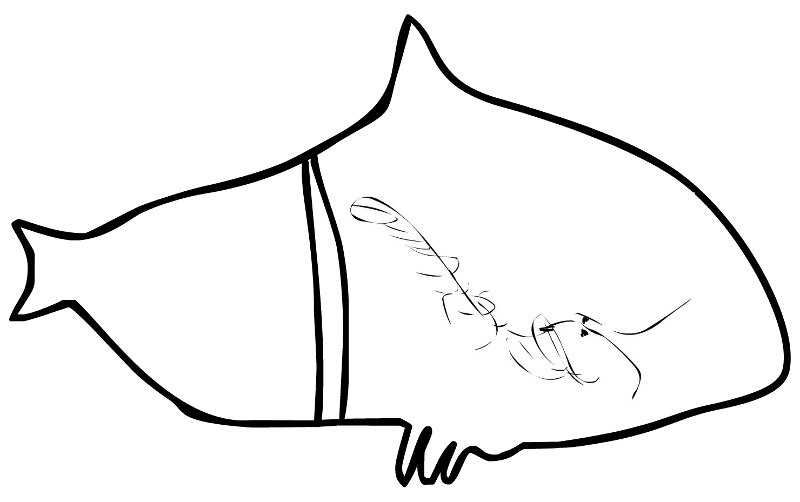
Ways of thinking as artists and as scientists combine to animate the humpback whale as it sings and travels its cyclic path through the Southern Ocean each year, between Australia and Antarctica: Drawing: Maddison Gibbs |
-50, 35 | Indigenous Cultural Knowledge, Art and Scientific Method | http://www.lunartime.net.au/content/library/sandtalkminds/dreaming/spirits-make-noise-dreaming.php |
| 101 | krill sex | So Kawaguchi et al. 2010 |
Art and science combine in the animation, Krill sex. In 2010 the entire mating dance of Euphausia superba (Antarctic krill) is observed for the first time on the sea floor around Antarctica. Krill mating was not expected to occur at ocean depth. This finding is expressed through art and scientific data, allowing scientists to inspire, as well as inform policy makers to recommend protection of this region. Key message: There are certain places where people must not intrude, in order to sustain life within natural limits. |
-65.87, 88 | Art and Scientific Method | https://academic.oup.com/plankt/article/33/7/1134/1556704 |

